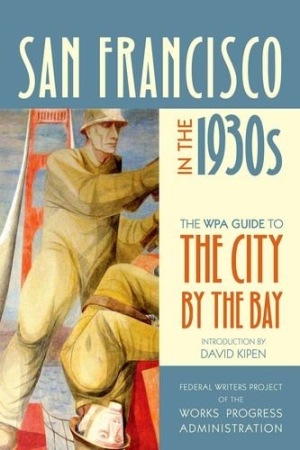San Francisco in the 1930's
The WPA Guide to the City by the Bay
At a time when politicians advocate de-funding National Public Radio and curtailing appropriations for the arts, it is difficult to recall that there was a time when the federal government actually paid writers to write books. From 1935 until 1943 the Federal Writers Project, part of the Works Progress Administration program created during the Great Depression to put people to work, paid writers to produce what became known as the American Guide series.
One of a series of travel guides to each of the forty-eight states (Alaska and Hawaii not yet being admitted to the Union) and several major American cities, San Francisco in the 1930s: The WPA Guide to the City by the Bay* was first published in 1940. The contemporary reprint has not been updated but includes an introduction by David Kipen, former book editor and critic of the San Francisco Chronicle, which serves as a prelude to a well orchestrated tour to this beautiful city.
San Francisco in the 1930s* offers a thorough overview of the city’s rich and colorful history. The account quickly covers the early years of exploration and settlement, beginning with Portuguese explorer Juan Rodrigues Cabrillo and the founding of the Mission of San Francisco in 1776. The section on the history of San Francisco also contains an enlightening discussion of the city’s literary heritage, populated with such luminaries as Bret Harte, Mark Twain, and Jack London, among others.
The Guide overflows with nuggets of information about the city and its people. For example, Stanford University was founded in nearby Palo Alto with the intent that it be a place for specialization, with an emphasis on “useful” education. There is a short section of “General Information,” telling readers where they might attend church, watch a cricket match, or find a good meal, all from the perspective of 1940. The book is also rich with maps and photographs of San Francisco as it was in the 1930s and lists of agencies and places where more information could be found. Each neighborhood is thoroughly reviewed and described.
San Francisco in the 1930s* is a guide to the surrounding towns and countryside, as well. The book concludes with chapters on several cities near San Francisco, including Oakland and Berkeley and, finally, a series of tours designed to be driven easily by anyone using the guide. As Kipen notes, this manual remains, nearly seventy-five years after its first publication, a useful book as well as an important historical volume: “For locals and newcomers alike, transplants and tourists both, a copy of San Francisco in the 1930s* belongs in every pannier of every rental bike the whole Bay around, and the glove box of every Zipcar besides.”
Reviewed by
John Michael Senger
Disclosure: This article is not an endorsement, but a review. The publisher of this book provided free copies of the book to have their book reviewed by a professional reviewer. No fee was paid by the publisher for this review. Foreword Reviews only recommends books that we love. Foreword Magazine, Inc. is disclosing this in accordance with the Federal Trade Commission’s 16 CFR, Part 255.

